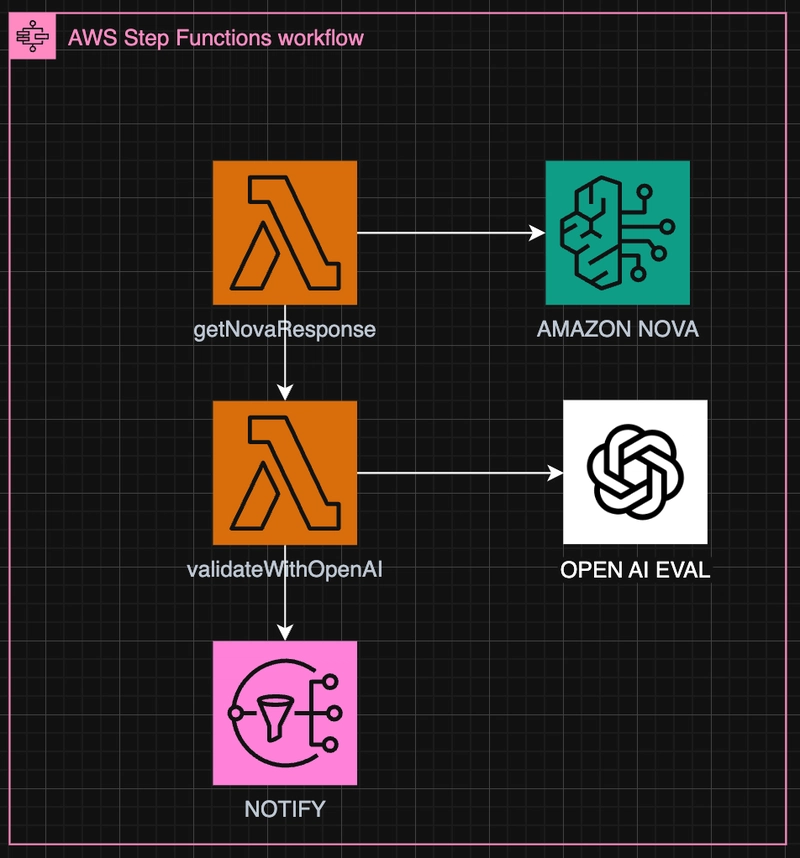When you're building with LLMs like Amazon Bedrock’s Nova, there's a tough question you’ll eventually have to face:
“How do I know my model’s answers aren’t basically AI Slop?”
We’re past the point where eyeballing responses are good enough — we need automated validation at runtime, ideally one that fits neatly into a serverless, production-friendly stack.
So let’s wire it up:
- ✍️ Nova (via Amazon Bedrock) generates a response
- 📊 OpenAI’s new Evals API grades the response
- 🤖 Step Functions + Lambda orchestrate it
- 🧱 CDK deploys the whole thing
- ✅ And we track responses over time to improve
Let’s go full-stack, eval-style baby
🧩 High level architecture
We’ll keep things TypeScript down xD
🛠 CDK stack
Here's a bare-bones CDK setup (in TypeScript) to deploy everything
const evalNotificationTopic = new sns.Topic(this, 'EvalNotificationTopic');
evalNotificationTopic.addSubscription(
new snsSubscriptions.EmailSubscription('your-email@example.com')
);
const getNova = new NodejsFunction(this, 'NovaFn', {
entry: 'lambda/getNovaResponse.ts',
environment: { REGION: 'us-east-1' }
});
const validateFn = new NodejsFunction(this, 'ValidateFn', {
entry: 'lambda/validateWithOpenAI.ts',
environment: {
OPENAI_API_KEY: process.env.OPENAI_API_KEY!,
}
});
const notifyTask = new tasks.SnsPublish(this, 'Notify', {
topic: evalNotificationTopic,
message: stepfunctions.TaskInput.fromText('Evaluation complete. Review results in OpenAI dashboard.'),
resultPath: stepfunctions.JsonPath.DISCARD,
});
const flow = new StepFunction(this, 'EvalFlow', {
definition: Chain
.start(new LambdaInvoke(this, 'Generate', { lambdaFunction: getNova }))
.next(new LambdaInvoke(this, 'Eval', { lambdaFunction: validateFn }))
.next(notifyTask)
});
What does this CDK stack drop?
- 2 Lambdas
- A Step Function workflow
- A SNS
Let’s break it down 👇
📦 Lambda 1 — Nova Response (getNovaResponse.ts)
const input = event.prompt ?? "What is the capital of France?";
const command = new ConverseCommand({
modelId: "amazon.nova-lite-v1:0",
messages: [{ role: "user", content: [{ text: input }] }],
inferenceConfig: { temperature: 0.5 },
});
const result = await client.send(command);
const output = result.output?.message?.content?.[0]?.text;
Returns something like:
{
"prompt": "What is the capital of France?",
"completion": "The capital of France is Paris."
}
🔍 Lambda 2 — Eval with OpenAI (validateWithOpenAI.ts)
const evalRequest = {
run_spec: {
eval_name: "cot-correctness",
args: {
samples_jsonl: [{
input: prompt,
completion: completion,
ideal: ["Paris"]
}]
}
}
};
Then POST to:
https://api.openai.com/v1/evals/runs
You get back a runId, which you can poll for results from (or you can automatically wait using another Step Function state if needed)
📊 Simulated Scenarios
Let’s run some examples and score them using the cot-correctness eval:
| Prompt | Nova Output | Expected | Eval Score |
|---|---|---|---|
| What is the capital of France? | Paris is the capital of France. | Paris | ✅ PASS |
| What is the square root of 64? | The square root of 64 is 8. | 8 | ✅ PASS |
| Who won the 2022 World Cup? | France won the 2022 World Cup. | Argentina | ❌ FAIL |
| What’s 17 + 26? | That would be 33. | 43 | ❌ FAIL |
| Define photosynthesis in 1 sentence. | Photosynthesis is how plants make food. | Reasonable | ✅ PASS |
🔁 How to improve When it fails
When your eval fails, here’s what you can do:
1. Tune inference settings
- Lower temperature for deterministic answers
- Increase
topPfor broader creativity (only if needed)
2. Improve prompt design
- What’s 17 + 26?
+ What’s 17 + 26? Answer only with the number
3. Upgrade your eval rubric
Use more specific Evals (e.g. cot-accuracy, exact-match, qa-relevance) or create custom ones to reflect your domain
4. Chain a retry state
In Step Functions, wrap failed evals with a retry flow using a different prompt phrasing or fallback model
That's all folks xD

Tidak ada komentar:
Posting Komentar